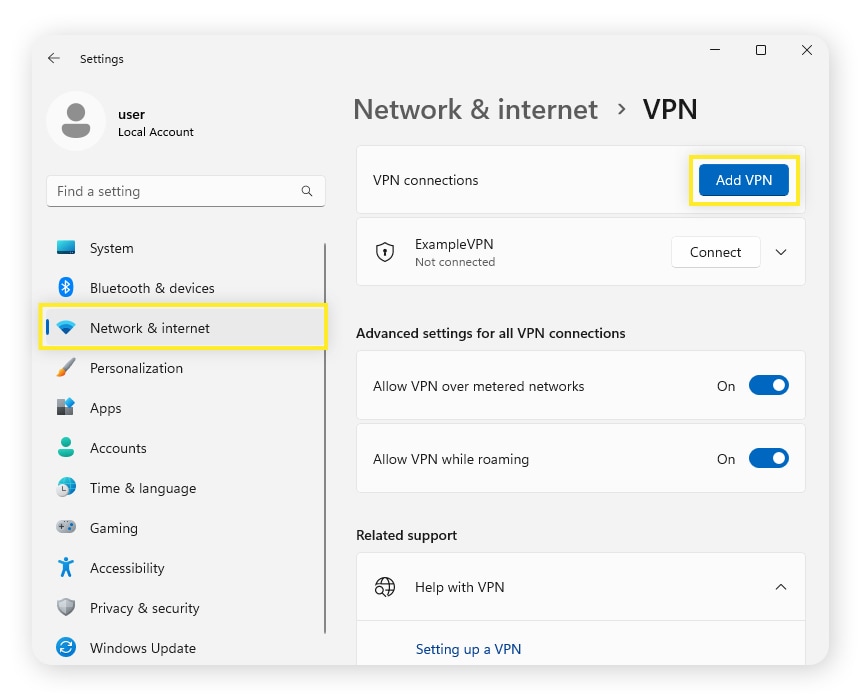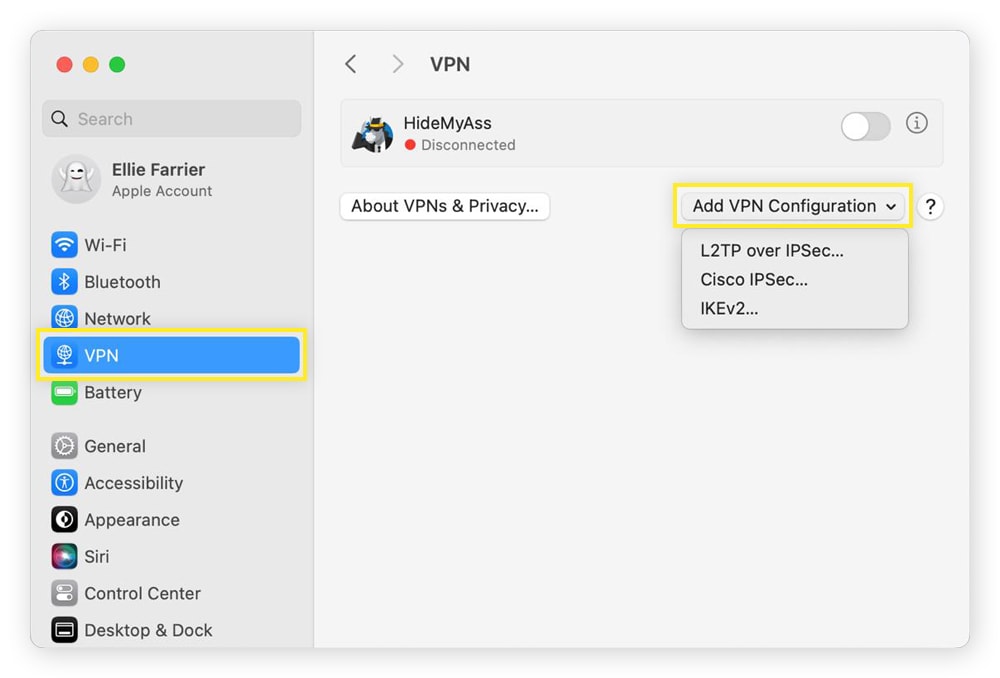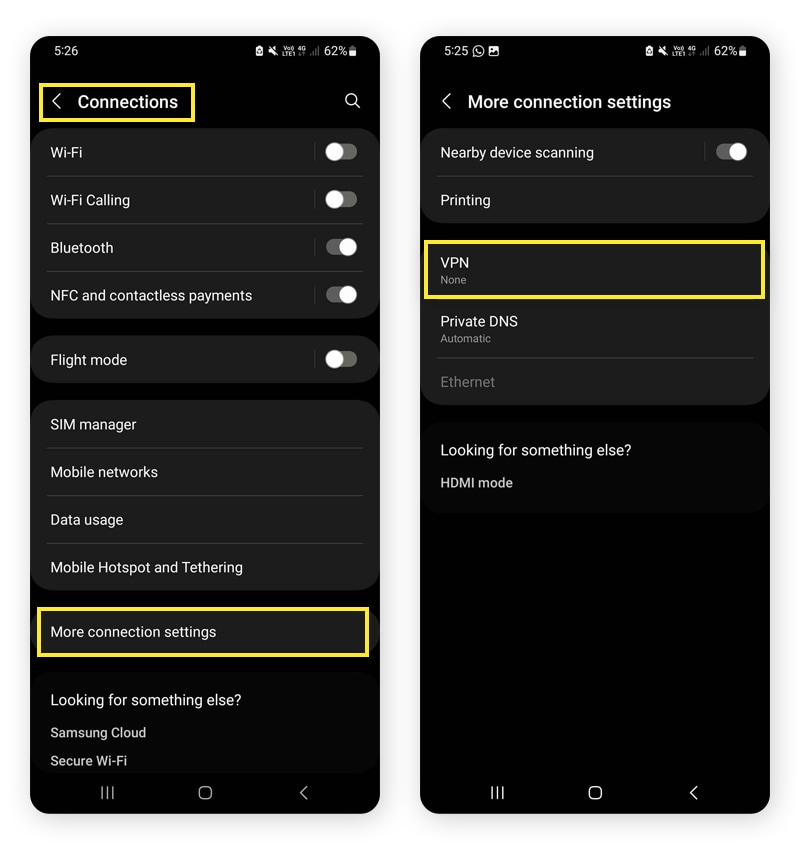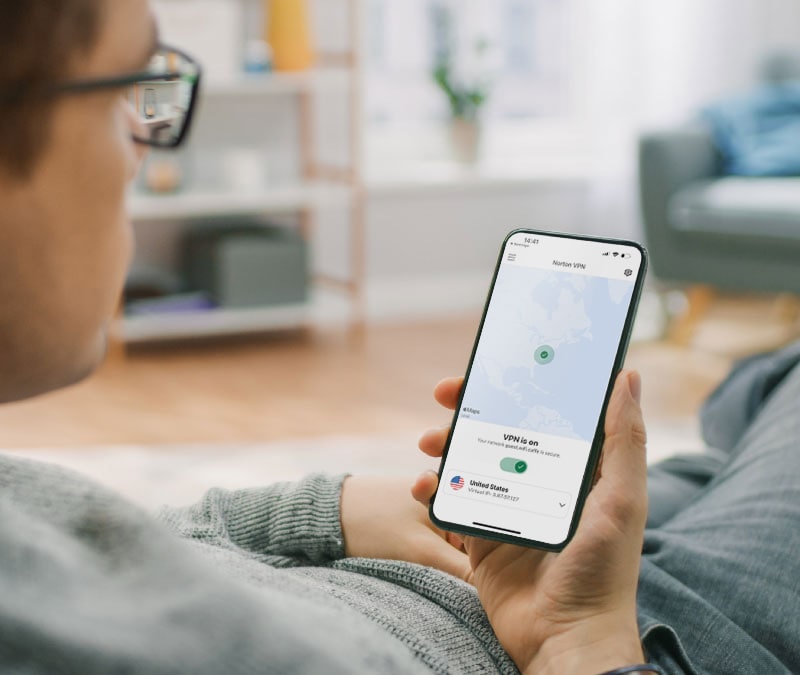How to set up a VPN on Windows, Mac, Android, and iPhone
Want to use a VPN to boost your online privacy or help you access content on the go? Learn how to set up a VPN in our guide, whether you’re on Windows, Mac, iPhone, or Android. Then, get a reliable VPN to simplify the process and help secure the data you send and receive online with just a click of a button.

Do I have to set up my VPN manually?
VPN service providers typically have apps that automate the set-up process for you, no matter what device you’re using. But you may need to manually set up a VPN when configuring it on an unsupported device, connecting to a workplace VPN from home, or when no app (or client) is available to simplify the process.
Remember that setting up a VPN manually on any device requires access to a VPN server, which typically comes with a subscription to a VPN provider or self-hosting your own server.
How to set up a VPN on a PC (Windows 10 and Windows 11)
If your VPN provider doesn’t have a VPN application for Windows and you need to manually set up a VPN on Windows 10 or 11, you can do it through your Windows settings.
Follow these steps to get your Windows VPN set up:
1. Go to Settings > Network & Internet > VPN. Click Add VPN.


2. Choose a name for the connection and enter the VPN’s server address.
3. Select the protocol for your VPN server from the VPN type drop-down menu (in most cases, you can leave this set to Automatic).
4. Choose the type of sign-in info your VPN server expects, set a username and password if you wish, then click Save.
To connect to the VPN, click the Network icon in the system tray, find your VPN, and click Connect. You should now be connected to the VPN you set up — confirm by checking that your IP address has changed.
How to set up a VPN on a Mac
Setting up a VPN on a Mac manually is a straightforward process, which can provide extra privacy when you’re connected to the internet — especially when you’re connected to unsecured networks such as public Wi-Fi in a local cafe or airport.
Here’s how to manually add a VPN connection on your Mac:
- Go to System Settings > VPN.
- Click Add VPN Configuration, and choose the correct protocol.


3. Enter the server address and account name, and set any other information you want, such as user authentication and password.
4. Click Create and provide any authentication required by your VPN server.
After setting up your VPN, connect by navigating to System Settings > VPN. Then, toggle on the new VPN you just set up.
How to set up a VPN on an Android
If you want to set up custom configurations, or don’t have a dedicated app to do it for you, you can also set up a VPN for Android on your smartphone. The instructions may vary slightly depending on your specific Android manufacturer — the steps below are relevant for Samsung phones.
Here’s how to set up a VPN on your Android:
- Go to Settings > Connections > More connection settings > VPN.


2. Tap the three dot menu in the top-right corner and tap Add VPN profile.
3. Fill in the form that pops up with the correct details for the VPN server you want to be able to connect to.


If you want to use the VPN connection in the future, it can be accessed via the More connection settings menu and enabled at any time.
How to set up a VPN on iPhone or iPad
If you’re wondering how to set up a VPN for your iPhone or iPad and your VPN provider doesn’t have a dedicated app, you can manually set one up.
Here’s how to configure a VPN connection via iOS Settings:
- Go to Settings > General > VPN & Device Management > VPN > Add VPN Configuration.
- Fill in the details required, such as description, server address, and authentication credentials, to set up the VPN.
Now, anytime you want to connect to the VPN you set up, go to Settings > General > VPN and turn on the VPN using the toggle switch.
How to set up a VPN on your router
You may want traffic from multiple devices to go through a VPN. If this is the case, it may be better to set up the VPN on your home router, rather than individually on each device. The exact methods differ depending on your router, and on some routers, manual setup isn’t even possible.
Here’s a general guide on how to set up a VPN on your router:
- Access the Settings page of your router.
- Look for VPN settings. There may be a dedicated section for these settings, or they may be in an advanced settings menu.
- Enter the VPN details as required, and test the VPN once setup is complete to ensure it’s working properly.
How to test your VPN to ensure it’s working
To make sure your VPN is working, there are several VPN tests to run to confirm you’re enjoying all the benefits of using a VPN and that you have sufficient download speeds.
Here are two quick tests to run after you set up a VPN to ensure that it’s working:
- Check your IP address: Search for “what is my IP?” in a Google search before connecting to the VPN and take note of the address. After you connect, do the same thing one more time — if your IP address changes, the VPN works.
- Test the connection speed: Before you connect to the VPN, go to speedtest.net and click Go. Make note of the upload and download speeds. Once you connect to the VPN, do the speed test again to get an idea of how the VPN affects your speed.
Troubleshoot if your VPN isn’t working
If the VPN you set up isn’t working, it could be for several different reasons. For instance, you could have chosen an incorrect VPN configuration or there may be a firewall interfering with your connection.
Here are some common problems that can cause a VPN not to work properly:
- Unstable Wi-Fi connection: A weak Wi-Fi connection can cause VPN issues or drop the connection entirely. To fix this, check your Wi-Fi signal strength, reconnect to the network, and verify you're using the correct network credentials.
- Incorrect VPN configuration: Ensure the VPN server details — like protocol and address range — are correct. Even small errors can prevent the VPN from working properly.
- Firewalls or other security appliances: If you have a more advanced setup that includes a standalone firewall, you may need to set a rule to allow your newly configured VPN traffic through your network.
- Issues with the VPN server: The VPN server may be down or experiencing issues. Try waiting a few minutes, switching server locations, or contacting your VPN provider for more information.
- Legal restrictions: In certain countries, VPNs are restricted or illegal. Ensure you stay updated on the laws in your country and understand the risks involved with VPN use.
Secure your online activity with Norton VPN
Setting up a VPN manually can be tricky, and a single misstep could leave you unprotected or unable to connect.
Norton VPN takes the hassle out of the configuration for you, allowing you to select your server location, choose a VPN protocol, and set up split tunneling and kill switch protection — all through a simple, user-friendly app. Get it on all your devices today and start browsing more securely and privately in seconds.
FAQs
What is the best VPN?
The best VPN comes from a trusted, reputable provider and includes essential privacy and security features like a strict no-log policy, bank-grade encryption, and advanced protection against tracking and data leaks. Norton VPN delivers all this and more, giving you a seamless, secure, and private browsing experience across all your devices.
Are VPNs free?
Some VPNs are free, but just because they don’t cost any money doesn’t mean they cost nothing at all. Free VPN providers might sell your data to fund their operations, and typically lack the range of advanced privacy and security features offered by premium VPN services.
What can I access with a VPN?
A VPN can help you access content while traveling, which can be useful when on an overseas holiday and wanting to access streaming content from your home country, making it seem like you are still at home.
Can I create my own VPN?
It is possible to create your own VPN by setting up a server on a cloud platform or hosting it on your own hardware. This gives you full control over the VPN configuration but requires technical expertise for setup and maintenance. Using a trusted VPN provider like Norton VPN offers a much simpler, hassle-free solution.
Editorial note: Our articles provide educational information for you. Our offerings may not cover or protect against every type of crime, fraud, or threat we write about. Our goal is to increase awareness about Cyber Safety. Please review complete Terms during enrollment or setup. Remember that no one can prevent all identity theft or cybercrime, and that LifeLock does not monitor all transactions at all businesses. The Norton and LifeLock brands are part of Gen Digital Inc.






Want more?
Follow us for all the latest news, tips and updates.